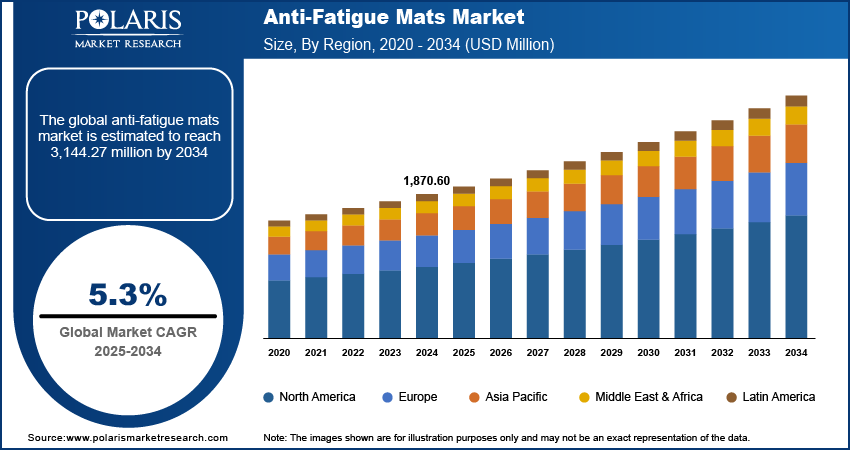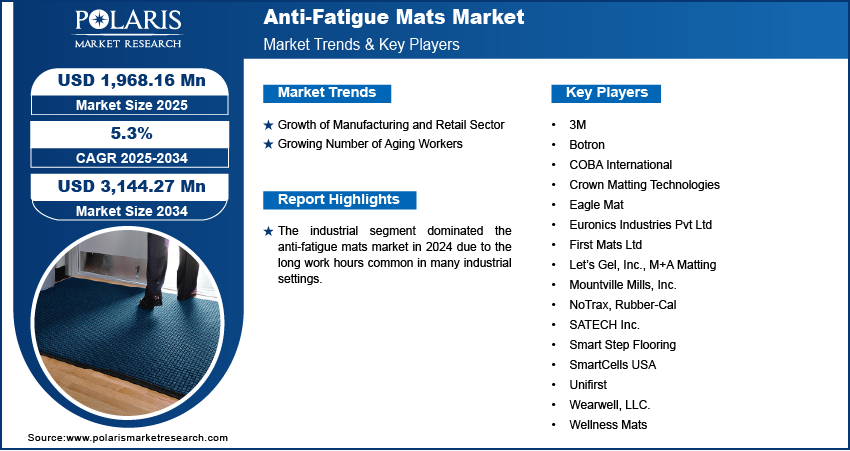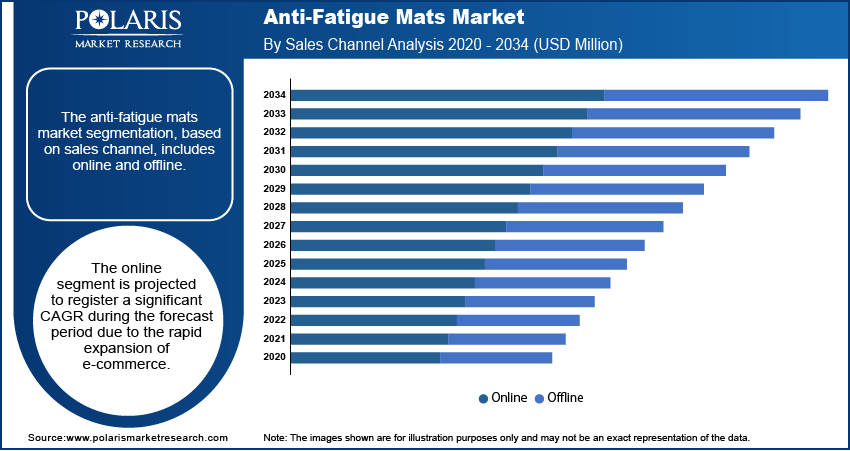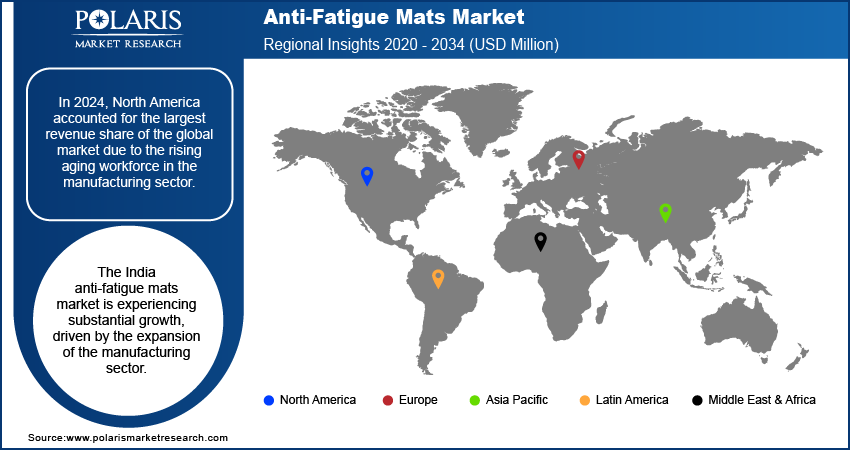
Anti-Fatigue Mats Market Size, Share, Trends, Industry Analysis Report
: By Material, Sales Channel (Online and Offline), End Use and Region (North America, Europe, Asia Pacific, Latin America, and Middle East & Africa) – Market Forecast, 2025–2034
- Published Date:Aug-2025
- Pages: 125
- Format: PDF
- Report ID: PM1721
- Base Year: 2024
- Historical Data: 2020-2023
Market Overview
The global anti-fatigue mats market size was valued at USD 1,870.60 million in 2024, growing at a CAGR of 5.3% from 2025 to 2034. The market growth is primarily driven by the increased emphasis among companies on creating more comfortable work environments and the introduction of advanced mats offering improved support and comfort.
Key Insights
- The online segment is projected to register a significant CAGR during the projection period. The wide variety of anti-fatigue mats available on e-commerce platforms, along with detailed descriptions and customer reviews, contributes to the segment’s robust growth.
- The industrial segment accounted for the largest market share in 2024. This is due to the rising adoption of anti-fatigue mats by industries to address worker fatigue issues and boost productivity.
- North America led the global market in 2024. The aging workforce in the manufacturing sector in North America has created a need for ergonomic solutions that reduce physical strain and enhance comfort.
- Asia Pacific is witnessing robust growth, primarily due to the expanding retail sector that has created a higher demand for anti-fatigue mats in the region.
Industry Dynamics
- The rise of retail, manufacturing, and service sectors has increased the number of hours workers spend standing. This has led to companies investing in anti-fatigue mats to improve comfort and productivity.
- The aging global workforce has led to an increased need for solutions that support the comfort and health of older workers, driving market expansion.
- The rise of remote work and flexible work arrangements is expected to provide significant market opportunities during the projection period.
- The high initial cost of manufacturing associated with anti-fatigue mats may present market challenges.
Market Statistics
2024 Market Size: USD 1,870.60 million
2034 Projected Market Size: USD 3,144.27 million
CAGR (2025-2034): 5.3%
North America: Largest Market in 2024

To Understand More About this Research: Request a Free Sample Report
Anti-fatigue mats are cushioned mats designed to reduce discomfort and fatigue caused by standing for long periods. They provide support to the feet, legs, and lower back, improving comfort and circulation in environments like kitchens, workstations, and retail counters.
Companies are increasingly recognizing the importance of employee well-being, leading to a growing focus on creating safer, more comfortable work environments. Many industries, particularly those where workers stand for extended periods, are adopting anti-fatigue mats to reduce physical strain. Additionally, businesses are aiming to improve employee satisfaction and reduce absenteeism, which is driving the demand for anti-fatigue mats and fueling the anti-fatigue mats market development.
Recent advancements in materials used for anti-fatigue mats have made them more effective and comfortable. New technologies, such as memory foam, gel, and high-quality rubber, have led to the development of mats that offer better support, durability, and comfort. These innovations make anti-fatigue mats more appealing to businesses seeking long-lasting solutions that enhance employee well-being. Manufacturers are now creating specialized mats with advanced features, including improved shock absorption and non-slip surfaces. The combination of better performance and continuous product innovation is propelling the demand for anti-fatigue mats, thereby boosting the anti-fatigue mats market revenue.
Market Dynamics
Growth of Manufacturing and Retail Sector
The growth of manufacturing, retail, and service industries has significantly increased the number of workers required to stand for long hours. For instance, according to the India Brand Equity Foundation, in April-January 2024, the index of industrial production rose by 143.4 points, showcasing growth in the manufacturing sector. In these environments, workers are exposed to fatigue, which can lead to decreased productivity and increased injury risks. To address these challenges, companies are increasingly investing in anti-fatigue mats to improve comfort and productivity. Therefore, the booming manufacturing and retail sectors are driving the anti-fatigue mats market demand.
Growing Number of Aging Workers
The global workforce is aging, creating a need for solutions that support the health and comfort of older workers. For instance, according to the US Bureau of Labor Statistics, in the US alone, 31,986 workers fall under the age group of 45 to 54 years in 2023, showcasing a large volume of an aging workforce. In industries such as healthcare, manufacturing, and retail, older employees face challenges related to standing for long periods, leading to fatigue and discomfort. As a result, the growing number of older workers in various industries has driven demand for anti-fatigue mats, as employers seek ways to improve ergonomics and reduce health risks, fueling the anti-fatigue mats market expansion.

Market Segment Insights
Market Assessment Based on Sales Channel
The anti-fatigue mats market, based on sales channel, is segmented into online and offline. The online segment is expected to experience a significant CAGR during the forecast period, driven by the rapid expansion of e-commerce. More consumers and businesses are turning to online platforms for their purchasing needs. Online stores offer a wide variety of anti-fatigue mats, with detailed product descriptions, customer reviews, and competitive pricing, making it an attractive option for buyers. The shift toward online shopping is anticipated to drive the online sales channel segment growth in the global market.
Market Evaluation Based on End Use
The anti-fatigue mats market, based on end use, is segmented into industrial, commercial, and residential. The industrial segment dominated the anti-fatigue mats market in 2024 due to the long work hours common in many industrial settings. Workers in manufacturing plants, warehouses, and assembly lines often spend extended periods standing, leading to fatigue and discomfort. To address these issues and improve productivity, businesses are increasingly adopting anti-fatigue mats, thereby driving the growth of the industrial segment in the global market.

Regional Analysis
By region, the study provides the anti-fatigue mats market insights into North America, Europe, Asia Pacific, Latin America, and the Middle East & Africa. In 2024, North America accounted for the largest revenue share of the anti-fatigue mats market, driven by the aging workforce in the manufacturing sector. As more workers approach retirement age, there is an increasing need for ergonomic solutions to reduce physical strain and improve comfort. Older workers are more susceptible to fatigue and discomfort from standing for long periods, making anti-fatigue mats a valuable tool for maintaining productivity and employee well-being. Additionally, companies are prioritizing the health of their aging workforce, which is driving the demand for anti-fatigue mats in the region.
The Asia Pacific anti-fatigue mats market is projected to experience significant growth in the global market, primarily driven by the expansion of the retail sector. Retail businesses are expanding, and more employees are working long hours on their feet, leading to increased demand for solutions that improve comfort and reduce fatigue. Additionally, the rise of retail stores, supermarkets, and shopping malls, especially in countries like China and India, is expected to create a higher demand for anti-fatigue mats in the region.
The market for anti-fatigue mats in India is experiencing substantial growth due to the expansion of the manufacturing sector. As industries, particularly automotive, textiles, and electronics, continue to grow, a larger workforce is required to work long hours standing on factory floors. This increasing demand for workers in manufacturing plants is driving the need for anti-fatigue mats to improve comfort and reduce strain. Additionally, with a greater focus on worker safety, health, and productivity, companies are increasingly adopting these mats as part of their workplace ergonomics. This trend is significantly fuelling the growth of the anti-fatigue mats market in India.

Key Players & Competitive Insights
The anti-fatigue mats market is constantly evolving, with numerous companies striving to innovate and distinguish themselves. Leading global corporations dominate the market by leveraging extensive research and development, and advanced techniques. These companies pursue strategic initiatives such as mergers and acquisitions, partnerships, and collaborations to enhance their product offerings and expand into new markets.
New companies are introducing innovative products to meet the demands of specific sectors. The competitive environment of the market is amplified by continuous progress in product offerings. A few of the key players in the anti-fatigue mats market include 3M; Botron; COBA International; Crown Matting Technologies; Eagle Mat; Euronics Industries Pvt Ltd; First Mats Ltd; Let’s Gel, Inc.; M+A Matting; Mountville Mills, Inc.; NoTrax; Rubber-Cal; SATECH Inc.; Smart Step Flooring; SmartCells USA; Unifirst; Wearwell, LLC.; and Wellness Mats.
3M, originally founded in 1902 as Minnesota Mining and Manufacturing Company, is a diversified technology and science corporation headquartered in St. Paul, Minnesota. The company operates in over 70 countries and sells products in over 200 countries. 3M’s business spans various industries, including industrial, safety, healthcare, and consumer markets. Its portfolio features more than 60,000 products, categorized into key business segments. 3M operates manufacturing facilities in multiple regions, including North America, with significant operations in the Asia Pacific, particularly in India and China. The company also maintains a robust presence throughout Europe.
COBA International Limited, established in 2004 and based in Leicester, UK, functions as a management holding company within the plastics industry. The company oversees several subsidiaries that manufacture a variety of plastic products for sectors such as automotive, electrical, and mechanical industries. The company's Engineering Centre, located in the East Midlands, supports its manufacturing capabilities by providing advanced engineering solutions tailored to client specifications. COBA operates primarily in the UK and Europe. The workforce comprises over 900 professionals who contribute to the company's operations across multiple locations.
List of Key Companies
- 3M
- Botron
- COBA International
- Crown Matting Technologies
- Eagle Mat
- Euronics Industries Pvt Ltd
- First Mats Ltd
- Let’s Gel, Inc.
- M+A Matting
- Mountville Mills, Inc.
- NoTrax
- Rubber-Cal
- SATECH Inc.
- Smart Step Flooring
- SmartCells USA
- Unifirst
- Wearwell, LLC.
- Wellness Mats.
Market Segmentation
By Material Outlook (Revenue – USD Million, 2020–2034)
- Foam Rubber
- Hard Rubber
- Gel
- Others
By Sales Channel Outlook (Revenue – USD Million, 2020–2034)
- Online
- Offline
By End Use Outlook (Revenue – USD Million, 2020–2034)
- Industrial
- Commercial
- Residential
By Regional Outlook (Revenue – USD Million, 2020–2034)
- North America
- US
- Canada
- Europe
- Germany
- France
- UK
- Italy
- Spain
- Netherlands
- Russia
- Rest of Europe
- Asia Pacific
- China
- Japan
- India
- Malaysia
- South Korea
- Indonesia
- Australia
- Rest of Asia Pacific
- Middle East & Africa
- Saudi Arabia
- UAE
- Israel
- South Africa
- Rest of Middle East & Africa
- Latin America
- Mexico
- Brazil
- Argentina
- Rest of Latin America
Market Report Scope
|
Report Attributes |
Details |
|
Market size value in 2024 |
USD 1,870.60 million |
|
Market size value in 2025 |
USD 1,968.16 million |
|
Revenue Forecast by 2034 |
USD 3,144.27 million |
|
CAGR |
5.3% from 2025–2034 |
|
Base year |
2024 |
|
Historical Data |
2020–2023 |
|
Forecast Period |
2025–2034 |
|
Quantitative Units |
Revenue in USD million and CAGR from 2025 to 2034 |
|
Report Coverage |
Revenue Forecast, Market Competitive Landscape, Growth Factors, and Trends |
|
Segments Covered |
|
|
Regional Scope |
|
|
Competitive Landscape |
|
|
Report Format |
|
|
Customization |
Report customization as per your requirements with respect to countries, regions, and segmentation. |
FAQ's
The market was valued at USD 1,870.60 million in 2024 and is projected to grow to USD 3,144.27 million by 2034.
The global market is projected to register a CAGR of 5.3% from 2025 to 2034
North America had the largest share of the global market in 2024.
3M; Botron; COBA International; Crown Matting Technologies; Eagle Mat; Euronics Industries Pvt Ltd; First Mats Ltd; Let’s Gel, Inc.; M+A Matting; Mountville Mills, Inc.; NoTrax; Rubber-Cal; SATECH Inc.; Smart Step Flooring; SmartCells USA; Unifirst; Wearwell, LLC.; and Wellness Mats are a few of the key players in the market.
The online segment is expected to experience significant CAGR during the forecast period due to the rapid expansion of e-commerce.
The industrial segment dominated the anti-fatigue mats market in 2024 due to the extended work hours common in many industrial settings.
